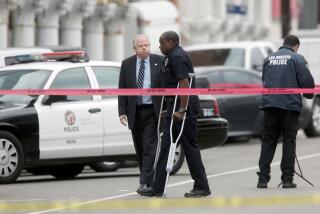D.A.s to Still Use Tactic on Gangs
They stormed into a Westminster cafe seeking revenge against a rival gang, allegedly arming themselves with bats, barbells and knives. But the would-be attackers found the tables turned when one of their targets drew a pistol, fired and killed one of the gang members.
Detectives spent months investigating the shooting. In the end, however, it was not the gunman whom authorities charged with murder--it was the victim’s gang friends.
Under a controversial legal theory, prosecutors argued that the 10 gang members provoked the killing themselves when they launched their initial attack at the cafe.
And despite a California Supreme Court ruling last month that significantly restricts when the theory can be used, prosecutors said they are moving forward with this case and several others. They have been using the theory for years to combat gang violence and have no intention of changing course although defense attorneys said they should.
“Are we going to stop? Absolutely not,” said Los Angeles County Deputy Dist. Atty. Janet Moore, who oversees the hard-core gang division. “We use it all the time. In certain drive-by cases, it’s about the only way we have of holding a gang member responsible for a death.”
The “provocative act” rule, which was established in 1965, allows authorities to charge people for murder when they commit a crime that ultimately ends in someone’s death, even if they never touched the victim.
In one of the first uses of the theory, prosecutors convicted a robber of the murder of his accomplice, who was fatally shot by police during a holdup in Huntington Beach.
But more recently, prosecutors have applied the tactic to gang vendettas as well. In 1991, following Los Angeles County’s lead, Orange County authorities charged four gang members with the killing of a colleague slain by rivals in a fierce gun battle they started.
Prosecutors acknowledge that such cases are not easy to win. Jurors sometimes have difficulty understanding the legal nuances of the doctrine, and judges have balked in some cases.
In December, an Orange County judge rejected murder charges filed against a gang member stemming from the fatal shooting of a friend. The defendant, Jose Luis Leon, had shouted to his friend to shoot at another group of men, but the gun jammed.
A fight between the two groups ensued. The gunman was disarmed, then fatally shot in the back. Judge Robert R. Fitzgerald dismissed the murder charge but convicted Leon of attempted murder, citing his involvement in the original attack.
“Prosecutors, particularly in these gang crimes, will try to get as many of these gang members as they can,” said Deputy Alternate Public Defender Dean Allen, who defended Leon in the case. “I think it’s sometimes an overreach.”
The Supreme Court thought so too.
In August, the court overturned the 1994 murder conviction of Israel Cervantes, a gang member who was charged with initiating the death of a fellow gang member by triggering a retaliatory killing at a Santa Ana house party.
Prosecutors argued that Cervantes put a deadly chain of events into motion when he shot a rival in the chest during a party.
Cervantes then left the scene. Moments later, five men who belonged to the wounded man’s gang armed themselves and went off in search of Cervantes and another member of his gang. They soon found one of Cervantes’ friends and fatally shot him.
In overturning the conviction, the court ruled that Cervantes was not guilty because he was not at the scene, and the five men who shot the victim were not part of the initial conflict.
Defense attorneys said they hope that the ruling will rein in prosecutors, especially in cases in which there is a tenuous link between the defendant’s actions and the killing.
“Who knows how far you can take it?” said defense attorney Creighton Laz. “At some point, you have to say enough is enough.”
But authorities are moving forward with similar prosecutions in Los Angeles and Orange counties, taking a narrow view of the high court’s ruling. They insist that none of their current prosecutions will be undermined by the court’s decision, including the case stemming from the March 13 Westminster cafe death of Andy Do.
Do, according to police, met with nine fellow gang members earlier in the day to look for rivals who had ambushed two friends the day before, disfiguring them during a knife attack. They spotted the rivals in front of the Mat Nhung Cafe.
As they got out of their car, Do was fatally shot and another member of his gang was wounded.
At first, detectives treated Do and his gang colleagues as victims in the shooting. But then a different picture began to emerge, said Westminster Police Sgt. Mark Nye.
“As the investigation continued, we realized they were the provocateurs, and they were the ones who needed to be dealt with,” Nye said.
The alleged gunman, Sang Ho, was charged with being a gang member and a felon in possession of a gun.
Prosecutors insist they have a solid case. Unlike the case overturned by the Supreme Court, they argue, all of the defendants were at the scene when the fatal shots were fired. And the attack at the cafe was an obvious act of provocation--one likely to lead to someone being killed. “One of their own guys is dead because of the acts they set in motion,” said Deputy Dist. Atty. Scott Simmons, who is prosecuting the case.
More to Read
Sign up for Essential California
The most important California stories and recommendations in your inbox every morning.
You may occasionally receive promotional content from the Los Angeles Times.












